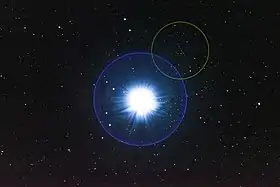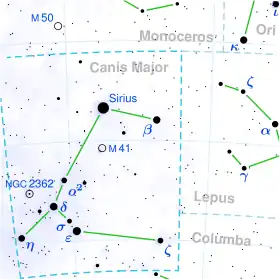| Gaia 1 | |
|---|---|
 Sirius and the Gaia 1 cluster | |
| Observation data (J2000 epoch) | |
| Right ascension | 6h 45m 52.8s[1] |
| Declination | −16° 45′ 00″[1] |
| Distance | 15 kly (4.6 kpc)[1] |
| Apparent dimensions (V) | 13 arcmins[1] |
| Physical characteristics | |
| Mass | 2.2×104[1] M☉ |
| Radius | 29 ly[1] |
| Estimated age | 6.3 Gyr[1] |
| Associations | |
| Constellation | Canis Major |

Gaia 1 is an open cluster of stars discovered in 2017 by astronomers using data from the Gaia Space Observatory. It is a high-mass and bright cluster, but remained unseen in prior astronomy due to veiling glare in ordinary telescopes overwhelmed by the star Sirius, which lies 10 arcmins west.[2] Its half-light radius is about 29 light-years (9 pc), assuming a distance of 15,000 light-years (4,600 pc), and it has an estimated mass of about 22,000 M☉.[1]
The Gaia 1 cluster was detected by researchers applying automated "star gauging" to the Gaia observatory's data on star locations.[3] This analysis surprisingly indicated a prominent concentration of stars, previously unknown and uncataloged, adjacent to Sirius. Gaia observed a cluster population of approximately 1,200 stars down to Gaia magnitude 19. Analysis of 2MASS data for those stars shows a red giant branch and a pronounced red clump that allows the absolute magnitude of the stars to be deduced and the distance calculated. Fitting the red giant branch also allows the age of the cluster to be calculated at 6.3 billion years.[1]
References
- 1 2 3 4 5 6 7 8 9 Koposov, Sergey E; Belokurov, V; Torrealba, G (2017). "Gaia 1 and 2. A pair of new Galactic star clusters". Monthly Notices of the Royal Astronomical Society. 470 (3): 2702. arXiv:1702.01122. Bibcode:2017MNRAS.470.2702K. doi:10.1093/mnras/stx1182.
- ↑ "gaia-satellite-reveals-hidden-star-clusters". Space.com. 5 December 2017. Retrieved 2018-01-31.
- ↑ "Gaia Mission Science Performance". European Space Agency.
External links
- How do you find a star cluster? Easy, simply count the stars. European Space Agency 15 November 2017